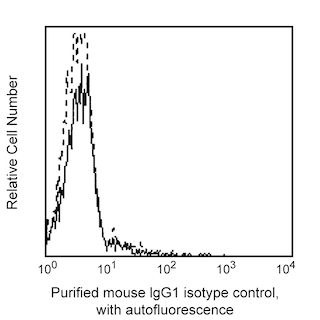Old Browser
This page has been recently translated and is available in French now.
Looks like you're visiting us from {countryName}.
Would you like to stay on the current country site or be switched to your country?




Flow cytometric analysis of CD141 expression on human peripheral blood monocytes. Whole blood was stained with either Purified Mouse IgG1, ĸ Isotype Control (Cat. No. 555746, dashed line histogram) or Purified Mouse Anti-Human CD141 antibody (Cat. No. 559780, solid line histogram); second step staining was performed with FITC Goat Anti-Mouse IgG/IgM (Cat. No. 555988). Erythrocytes were lysed with BD Pharm Lyse™ Lysing Buffer (Cat. No. 555899). The fluorescence histograms were derived from gated events with the forward and side light-scatter characteristics of viable monocytes.


BD Pharmingen™ Purified Mouse Anti-Human CD141

Regulatory Status Legend
Any use of products other than the permitted use without the express written authorization of Becton, Dickinson and Company is strictly prohibited.
Preparation And Storage
Product Notices
- Since applications vary, each investigator should titrate the reagent to obtain optimal results.
- An isotype control should be used at the same concentration as the antibody of interest.
- Caution: Sodium azide yields highly toxic hydrazoic acid under acidic conditions. Dilute azide compounds in running water before discarding to avoid accumulation of potentially explosive deposits in plumbing.
- Sodium azide is a reversible inhibitor of oxidative metabolism; therefore, antibody preparations containing this preservative agent must not be used in cell cultures nor injected into animals. Sodium azide may be removed by washing stained cells or plate-bound antibody or dialyzing soluble antibody in sodium azide-free buffer. Since endotoxin may also affect the results of functional studies, we recommend the NA/LE (No Azide/Low Endotoxin) antibody format, if available, for in vitro and in vivo use.
- Please refer to www.bdbiosciences.com/us/s/resources for technical protocols.
Companion Products





.png?imwidth=320)
The 1A4 monoclonal antibody specifically binds to CD141. CD141 is a 75 kDa, single chain, type I membrane glycoprotein referred to as thrombomodulin and fetomodulin. CD141 is expressed on endothelial cells, smooth muscle cells, epithelial cells, synovial lining cells, and keratinocytes. It is also found on megakaryocytes, dendritic cells, peripheral blood monocytes, and neutrophils, but not on lymphocytes. Reports indicate that CD141 plays an important role in Protein C activation and the initiation of the Protein C anticoagulant pathway. Thrombin loses its procoagulant function when it binds to CD141, and the CD141/thrombin complex is able to activate Protein C.
Development References (2)
-
Kishimoto T. Tadamitsu Kishimoto .. et al., ed. Leucocyte typing VI : white cell differentiation antigens : proceedings of the sixth international workshop and conference held in Kobe, Japan, 10-14 November 1996. New York: Garland Pub.; 1997.
-
Teasdale MS, Bird CH, Bird P. Internalization of the anticoagulant thrombomodulin is constitutive and does not require a signal in the cytoplasmic domain. Immunol Cell Biol. 1994; 72(6):480-488. (Biology). View Reference
Please refer to Support Documents for Quality Certificates
Global - Refer to manufacturer's instructions for use and related User Manuals and Technical data sheets before using this products as described
Comparisons, where applicable, are made against older BD Technology, manual methods or are general performance claims. Comparisons are not made against non-BD technologies, unless otherwise noted.
For Research Use Only. Not for use in diagnostic or therapeutic procedures.
Report a Site Issue
This form is intended to help us improve our website experience. For other support, please visit our Contact Us page.